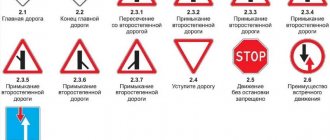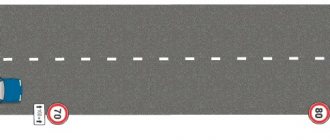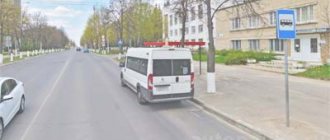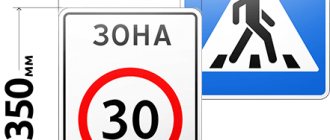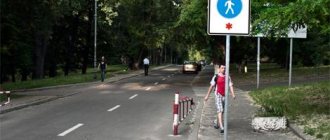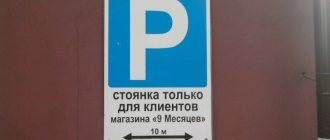Residential zone sign
A residential zone is an area whose boundaries are indicated by road signs 5.21 and 5.22.
Section 17 of the Highway Code requires a number of rules to be followed within this zone. In courtyard areas, these rules are also mandatory. Previously, the traffic rules did not contain a “Residential zone” sign, so still not every driver fully understands what is hidden under this concept, what speed is considered acceptable, and what fine will be imposed if it is exceeded. A limited area is considered residential, which is marked on both sides with appropriate signs. The traffic rules now have a whole section dedicated to driving through such territories.
The residential zone is an area whose boundaries are indicated by road signs 5.21 and 5.22
It is worth noting that in this area a pedestrian has an advantage over absolutely any vehicle.
He can walk both on the sidewalks and on the road itself, so the speed at the “Residential zone” sign should be reduced to 20 km/h. The pedestrian has an undeniable advantage over the driver, who must give way to him. True, a pedestrian also needs to be alert - there is no point in deliberately creating an obstacle in the path of a car. Even without a "Cycling" sign in this area, cyclists also have additional benefits.
Within the residential area, the same traffic rules apply as elsewhere. But others are added to them:
- Motorists are prohibited from leaving their car in a parking lot with the engine running. The engine must be turned off immediately if the vehicle is stationary for more than 5 minutes;
- a strict ban has been imposed on stopping and parking a car on the lawn;
- through traffic is strictly prohibited;
- training driving is prohibited;
- Parking of trucks weighing more than 3.5 tons is prohibited. There are special parking lots with marked spots for them.
- when moving out of this territory, the driver must give way to other vehicles;
- Maneuvering according to traffic rules is carried out only in cases of extreme necessity.
Residential zone in traffic rules
A residential zone is an area whose boundaries are indicated by road signs 5.21 and 5.22. Section 17 of the Highway Code requires a number of rules to be followed within this zone. In courtyard areas, these rules are also mandatory.
A courtyard area is a space inside the perimeter formed by residential buildings, or between buildings, on which flower beds, lawns, recreation areas, children's and sports grounds are located.
The roadway located inside such a zone is primarily intended for pedestrians and cyclists; they have priority here.
The car must allow them to pass (check-in and check-out is no exception). Unnecessarily, pedestrians (cyclists) do not need to interfere with the movement of cars. The speed is limited to 20 km/h. Prohibited: instructional driving; through traffic; parking for category “C” freight vehicles; parking with the engine running.
The Administrative Code and traffic rules in courtyards and residential areas prohibit:
The roadway located inside such a zone is primarily intended for pedestrians and cyclists
- park trucks weighing more than 3.5 tons (if there is no special parking);
- park: on flower beds, lawns or areas with plantings;
- Park: on children's or sports grounds;
- Parking: on the sidewalks.
Inside a residential area, a pedestrian has legal advantages over a car. Residential or courtyard areas are not intended for the transit of vehicles.
You should only enter it if necessary:
- you live in this place;
- came to someone on business;
- you work there;
- intend to buy something;
- it is necessary to disembark a passenger or unload cargo (pick up a passenger, load cargo).
Yard area in traffic rules
Yard area (definition) is a space limited by buildings along the perimeter, inside which, as a rule, there are children's playgrounds, recreation areas, green spaces, local passages to houses, schools, kindergartens, etc.
Unlike residential areas, courtyard areas are not indicated by road sign 5.21 and do not have a network of local streets and driveways. But all restrictions on vehicle movement also apply in these territories.
There is no official definition of the term “Yard Territory” in the Traffic Regulations. But courtyards (residential areas not marked with sign 5.21) belong to the adjacent territory in which these Rules apply.
Definition of the term Yard territory
A yard area is an area adjacent to a residential building and is in common use by the persons living there, limited along the perimeter by residential buildings, structures, structures or fences. In the courtyard area, for the benefit of persons living in the residential building to which it is adjacent, there are children's playgrounds, places for recreation, drying clothes, car parking, green spaces and other public facilities.
Yard territory is an area adjacent to a residential building and limited by residential buildings, structures, structures or fences, including approaches and entrances to the house, parking lots, green areas, areas for games, recreation and sports, and utility areas.
This is interesting: Mortgage Apartment From Bidding Therefore Return of Maternal Capital
Traffic rules in residential areas and courtyards
The traffic rules use such terms as “residential area” and “yard area”, which includes the courtyards of apartment buildings. Traffic rules regulate traffic rules in residential areas and courtyard areas, clause 17.4, and if the rules are not followed, a fine is imposed.
What is a residential area and courtyard area?
Residential zone - an area in a populated area in which there are residential buildings, laundries, dry cleaners, baths, clinics, schools, places of worship, parking lots, garages and other objects associated with human habitation.
The boundaries of the residential area are defined by signs:
- residential zone sign 5.21 indicates the entrance to a residential zone,
- sign for residential zone 5.22 - exit from it.
Territories of courtyards and extended residential settlements also belong to residential zones.
Territories of courtyards and extended residential settlements also belong to residential zones, and accordingly, all the rules associated with residential zones will also apply to them.
Such areas may not be residential. Entry and exit signs can be placed on specific streets or sections of them in a shopping area or even a business center, since in these places it is necessary to create suitable conditions for passers-by, limiting the speed of movement, without imposing a complete ban on vehicle traffic.
A courtyard area is an area surrounded by buildings that surrounds:
- playgrounds;
- green spaces;
- places for rest;
- local driveways to houses, schools, kindergartens, etc.
Residential area and courtyard area are not always identical concepts. The boundaries of a residential zone are delineated by road signs, and there is no definition of “yard territory” in any legislative acts at all. However, signs establishing a residential zone in cities are extremely rare, so most often such zones are understood as courtyard areas.
The maximum speed in residential areas and courtyards is 20 km/h. Clause 10.2 Traffic Regulations
In residential areas it is prohibited:
- through passage (through these territories without reducing speed);
- training ride;
- stopping for more than 5 minutes with the engine running;
- parking of trucks over 3.5 tons.
In winter, motorists are tacitly allowed to deviate from these regulations when it is necessary to warm up the engine, clear the snow from the car, or clear the driveway after an overnight snowfall.
In residential areas, priority for pedestrians is established (clause 10.2 of the traffic rules). Drivers when driving in a residential area are required to give way to pedestrians, and practice driving is also prohibited. The maximum speed in residential areas and courtyards is 20 km/h. (Clause 10.2 of the Traffic Regulations).
Through traffic in a residential area is prohibited, but it is possible to avoid violating the Rules if you stop inside it and then continue driving.
When leaving a residential area or entering a residential area, the driver of the vehicle, according to the Rules, gives way to any traffic participant, regardless of the direction in which he is moving.
Registration of the local area as collective property
Land surveying is the first step for residents to privatize their local area. And, strictly speaking, the only one.
Back in 2010, the Constitutional Court recognized a special procedure for transferring ownership of land under any multi-apartment building to apartment owners.
Unlike the privatization of lands for other purposes, after a new land plot is allocated and registered in the cadastral register by an act of municipal authorities or at the request of home owners, the right to it automatically passes to the owners of the house.
Obtaining land ownership has a number of undeniable advantages:
- by decision of the general meeting, it can be used for profit - rented out;
- the city cannot build anything on such a site without the consent of the legal owners;
- If it is necessary to use the local area for public needs, the municipality can only purchase the site or part of it.
This is important to know: How to get out of SNT if you own land: procedure and consequences
In addition, you will need to pay land tax annually. The amount will have to be calculated independently and then distributed proportionally among all owners. The larger the area of the occupied apartment or commercial premises, the higher the tax will be.
Section 17 of the traffic rules of the Russian Federation, traffic in residential areas
In a residential area, that is, in an area whose entrances and exits are indicated by signs 5.21 and 5.22, pedestrian movement is permitted both on sidewalks and on the roadway. In a residential area, pedestrians have priority, but they should not create unreasonable interference with the movement of vehicles *(113).
The Rules give the term “residential area” a broader meaning than in urban planning practice or everyday life. This can be not only the territories of the so-called urban “dormitory” areas, but also individual streets (or sections of streets) in the business and commercial part of the city, where it is necessary to provide more favorable conditions for pedestrians, without prohibiting the movement of vehicles altogether.
The speed of movement both in residential areas and in courtyard areas should not exceed more than 20 km/h
In areas marked with signs 5.21 and 5.22, as a rule, pedestrian traffic predominates. At the same time, the movement of vehicles is sporadic and occurs along local roads and streets. Sign 5.21 operates according to the zonal principle, that is, its coverage area is limited by the “fender” sign 5.22 “End of residential area”. A driver within a “residential zone” is in all cases obliged to give way to pedestrians moving along the roadway, including outside pedestrian crossings.
In a residential area, through traffic, practice driving, parking with the engine running, as well as parking of trucks with a permissible maximum weight of more than 3.5 tons outside specially designated and marked areas *(114) are prohibited.
This paragraph sets out restrictions on the movement and parking of vehicles within the “residential zone”. It prohibits through traffic, practice driving, parking of vehicles with the engine running, as well as parking of trucks with a permissible maximum weight of more than 3.5 tons outside a special parking area.
When leaving a residential area, the driver is obliged to let both pedestrians and other vehicles pass, regardless of the direction of their movement.
The “residential zone” has the status of an area adjacent to the road in relation to the road or roads that border the “residential zone” on one or more sides (see comments on the term “adjacent territory” in paragraph 1.2 of the traffic rules). Therefore, when leaving a “residential area”, the driver is obliged to let both pedestrians and other vehicles pass, regardless of the direction of their movement.
The requirements of this section also apply to courtyard areas.
Unlike the “residential zone,” courtyard areas do not have a network of local streets and driveways. However, all of the above restrictions apply in such territories, although they are not marked with signs 5.21 and 5.22. The courtyard area should be understood as the space between residential buildings or limited along the perimeter of buildings.
Inside courtyard areas, as a rule, there are children's playgrounds, places for recreation, green spaces, local passages to houses, schools, kindergartens, etc., located in this territory. Courtyard areas are most characteristic of the so-called quarterly urban development, which has become widespread in many cities.
The speed of movement both in residential areas and in courtyard areas should not exceed more than 20 km/h (clause 10.2 of the Russian Traffic Regulations).
Standards for cleaning the territory for a janitor according to the law
Cleaning of the territory of households is carried out in accordance with the standards that are established, including for janitors. Such issues are regulated by the Resolution of the Ministry of Labor and the Order of the State Construction Committee - the documents are discussed below.
It is important to understand that the standards in each case are established by a specific organization, but they cannot contradict the norms of federal legislation. The employee must find out such information before signing an employment contract. As a rule, the table of norms is given:
10 Jun 2021 lawurist7 1567
Share this post
- Related Posts
- I am a Labor Veteran Can I Take Benefits on Utilities If I'm Not Owned?
- State Registration of a Land Plot Lease Agreement for 49 Years
- 664 Traffic Police Order 2021 Did not introduce himself
- Chernobyl Zones in Krasnodar Territory
Residential zone in traffic rules
A residential zone is an area whose boundaries are indicated by road signs 5.21 and 5.22. Section 17 of the Highway Code requires a number of rules to be followed within this zone. In courtyard areas, these rules are also mandatory.
A courtyard area is a space inside the perimeter formed by residential buildings, or between buildings, on which flower beds, lawns, recreation areas, children's and sports grounds are located.
The roadway located inside such a zone is primarily intended for pedestrians and cyclists; they have priority here. The car must allow them to pass (check-in and check-out is no exception). Unnecessarily, pedestrians (cyclists) do not need to interfere with the movement of cars. The speed is limited to 20 km/h.
Inside a residential area, a pedestrian has legal advantages over a car. He can move along the roadway as if on a sidewalk. The driver does not have the right to signal to demand that the roadway be cleared. The pedestrian has the right of way (as does the cyclist, scooter), the driver must yield. Pedestrians also have priority when arriving and leaving.
Inside a residential area, a pedestrian has legal advantages over a car.
Residential or courtyard areas are not intended for the transit of vehicles. From the moment you entered the coverage area of sign 5.21 or any courtyard area until the moment you left (sign 5.22), you are required to follow the traffic rules established by the traffic police.
Prohibited:
- educational driving;
- through traffic;
- parking for category “C” freight vehicles;
- parking with the engine running.
The Administrative Code and traffic rules in courtyards and residential areas prohibit:
- park trucks weighing more than 3.5 tons (if there is no special parking);
- park: on flower beds, lawns or areas with plantings; on children's or sports grounds; on the sidewalks.
Adjacent territory of an apartment building
When purchasing an apartment, each shareholder knows for sure that after completion of the transaction he will become the full owner of the home. But at the same time, not every new resident thinks about who owns the territory adjacent to the house. By simple logic, it should be the property of the residents of the apartment building built on it, because the adjacent area with its squares, benches and playgrounds was originally planned for the recreation of people living in the house.
This is interesting: Is it possible to do repairs in Samara on weekends?
You can give permission to install a kiosk in the yard and manage the entire rent of its owner. Owners of the local area have the right to demand rent from the owners of hairdressers, supermarkets and other establishments that are located on the ground floors with corresponding access roads and extensions and transfer it to the house account.
Traffic in residential areas
In the Rules, the term “Residential zone” is given a broader meaning than in urban planning practice or everyday life. This can be not only the territories of the so-called urban “dormitory” areas, but also individual streets (or sections of streets) in the business and commercial part of the city, where it is necessary to provide more favorable conditions for pedestrians, without prohibiting the movement of vehicles altogether.
There is an opinion among drivers that the rules of movement in residential areas apply only when there is a corresponding sign at the entrance to such an area - a schematic image of a house and people on a blue background (clauses 5.21 and 5.22 of the traffic rules). In fact, the rules must be followed in all internal passages and courtyards. The easiest way to distinguish a residential area from a small street or alley is by toponymy - internal passages do not have official names.
In a residential area, the speed is limited to 20 km/h (clause 10.2), and priority remains with pedestrians, who are allowed to move both on sidewalks and on the roadway. However, the rules prohibit pedestrians from intentionally obstructing traffic. Thus, if there is a sidewalk along the road, the pedestrian should move along it.
In addition, through traffic is prohibited in courtyards (although motorists like to avoid traffic jams in courtyards), practice driving, and parking with the engine running (more than 5 minutes). However, in cold weather, drivers are tacitly allowed to deviate from the parking requirement if it is necessary to warm up the engine and clear the snow from the car. Well, drivers of heavy vehicles with a curb weight of more than 3.5 tons do not have the right to park their vehicles in courtyards and residential areas.
Features of driving in residential and yard areas
Most drivers are not aware that a yard and a residential area have some significant differences, and there are rules for each of these concepts, so it is worthwhile to firmly understand the differences between these definitions. The traffic rules in paragraph 17.4 state that all paragraphs of this section, called “Traffic in residential areas,” are fully transferred to the wording “yard areas.”
However, the concepts themselves are not the same and these are different areas, although people live in both. There are even different visual signs to differentiate the traffic rules, which means that the residential area is different from the courtyard area. As for the concept of “yard territory”, there is simply no clear formulation and explanation in the traffic rules.
To leave courtyard areas or residential areas, there are requirements defined by traffic rules
However, the courtyard area may be included in the area of the residential area, in turn, the residential area can also be a certain part of the courtyard area. Apparently, this is why in the traffic rules, in section 17, unifying rules for both territories and zones were introduced, although this did not make the difference any clearer. But the remaining sections of the traffic rules cannot be summed up under a single line; they relate only to a certain territory, which is directly discussed in a separate paragraph of the rules.
For leaving courtyard areas or residential areas, there are requirements defined by traffic rules. When leaving the courtyard area, the driver is obliged to let anyone who is at that moment taking part in movement next to, in front of or behind the car pass. According to the current rules, clause 10.2, it is allowed to move in residential areas and courtyards at a speed of no more than 20 km/h.
According to traffic rules, driving through courtyards and residential areas in drafts is prohibited, but at the same time, who can catch you in this, if you are driving through, stop in the courtyard and, without turning off the engine, move on in 10 seconds. In this case, no one will accuse you of violating the rules and there is nothing to fine you for.
The amount of the fine varies in different regions of residence in St. Petersburg and Moscow, the amount ranges from 1,500 to 3 thousand rubles
Fines for violations in residential areas
The amount of the fine varies in different regions of residence. In St. Petersburg and Moscow, the amount ranges from 1,500 to 3 thousand rubles.
Deprivation of a driver's license occurs in case of gross violations of traffic rules - exceeding the speed of movement in a residential area up to 80 km/h. The driver's license is taken away for 12 months.
Drivers of cars and trucks must move correctly both in the yard and when leaving it. Sanctions for violation are also imposed in the absence of the 5.21 sign in the yard.
Legal problems
- determining the size and boundaries of the PT;
- nature of use;
- management features.
The fact is that common property belongs to everyone. This means that while a person has the right to use and dispose of property, he cannot do anything alone. All decisions regarding PT are made only by a majority vote at the general meeting.
This is how the peculiarities of managing local areas manifest themselves. At the general meeting, residents decide on the placement of new facilities not included in the project, the allocation of plots for parking, landscaping, and recreational areas.
The main legal problem is determining the boundaries and area of the local area. The fact is that such territories were not allocated for houses of old construction. Yes, some buildings and courtyards did not have, there were only streets and areas like a well. Since buildings built before the nineties of the twentieth century were in state ownership, issues of development of adjacent areas were resolved at the level of local authorities.
For this reason, there are many buildings in cities that formally do not have adjacent areas. Sometimes there is simply nowhere to form them. At the same time, there is a method for calculating PT in accordance with the total area of the apartments of a given building. In order for a house to have its own official local area, property owners need to hold a general meeting (the quorum is two-thirds of the total number of owners), make a decision and contact the municipal authorities with a request to carry out land management work.
Land managers must not only determine the area of the PT, but also mark it on the ground. This will be useful for further actions on the use of land owned by the owners of the apartments of this building. After carrying out the work and receiving the technical plan, a package of documents is submitted to the Rosreestr authorities. If the applicants are denied registration of the PT as part of the property, then such a decision can be appealed in court.
Rules for placing objects
Everything that is located in the local area is a consequence of the implementation of the project, the decision of the residents of the house, or the illegal actions of people who want to benefit. After the house is built and put into operation, the so-called landscaping is carried out. The objects provided for by the project must be handed over along with the house. Everything else is finalized by the owners.
The biggest problem in the courtyards of urban apartment buildings is parking. Older houses were not designed for a large number of cars. Moreover, historical buildings were generally erected without taking into account the availability of personal transport. For this reason, when managing local areas, the organization of parking spaces is of great importance.
Who serves the territory
The fact that the adjacent territory belongs to all apartment owners does not mean that they all service it at once or in turn, although this is also possible. By decision of the general meeting, apartment owners choose a management company that not only ensures the viability of the house, but also maintains the surrounding area in proper order.
The scope of work depends on the agreement between the residents and the management company. However, usually such an organization carries out work on:
- cleaning the area;
- arrangement of recreational areas, including children's playgrounds;
- the formation of areas with green spaces;
- repairing roads in the yard;
- care of all PT facilities.
So, when choosing a management company and concluding an agreement with it, residents need to carefully consider all the points of mutual obligations.
If the local area is not allocated or some of the objects are, by force of circumstances, owned by the municipality or some department, then the general meeting or initiative group will have to interact with the management of the institutions, forcing them to take the necessary actions. If there is no provision in the agreement for maintenance, for example, of the road and sidewalks, the issue of a one-time event to pay for road repair work at the expense of the residents of the house will have to be put on the agenda of the general meeting.
This is important to know: Land compensation for a disabled person of group 2
You will have to equip the yard with video cameras yourself. To do this, you can enter into an agreement with an organization working on the “safe yard” project. The agreement can be concluded either with an individual or with the owners of several apartments. The advantages of this project are that with the help of a video camera placement system it is possible to cover almost the entire local area with round-the-clock surveillance.


